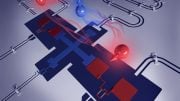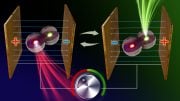
A recent study has introduced a potent combination of diamond and lithium niobate for quantum technologies, achieving a remarkable 92% light transmission efficiency. This advancement promises to enhance the development of quantum computing and communication networks.
Diamond and lithium niobate are combined to serve as a core component for future quantum technologies
Diamond and lithium niobate are often touted as high-performance quantum materials. Now, in a result supported by the Q-NEXT center, scientists have combined the two materials as a single quantum device, with exciting results.
Quantum information scientists are always on the hunt for winning combinations of materials, materials that can be manipulated at the molecular level to reliably store and transmit information.
Following a recent proof-of-principle demonstration, researchers are adding a new combination of compounds to the quantum materials roster.
In a study reported in ACS Photonics, researchers combined two nanosized structures — one made of diamond and one of lithium niobate — onto a single chip. They then sent light from the diamond to the lithium niobate and measured the fraction of light that successfully made it across. The greater that fraction, the more efficient the coupling of the materials, and the more promising the pairing as a component in quantum devices.
The result: An extraordinary 92% of the light made the jump from diamond to lithium niobate.
The research was supported in part by Q-NEXT, a U.S. Department of Energy (DOE) National Quantum Information Science Research Center led by DOE’s Argonne National Laboratory. Stanford University’s Amir Safavi-Naeini and Jelena Vuckovic led the study.
“It was an exciting result to get 92% efficiency from this device,” said Hope Lee, paper co-author and a Ph.D. student at Stanford University and researcher who worked with Q-NEXT Director David Awschalom while an undergraduate at the University of Chicago. “It showed the advantages of the platform.”
A bit about qubits
Quantum technologies harness special features of matter at the molecular scale to process information. Quantum computers, networks, and sensors are expected to have an enormous impact on our lives in areas such as medicine, communication, and logistics.
Quantum information is delivered in packets called qubits, which can take many forms. In the research team’s new platform, qubits transmit information as particles of light.
Reliable qubits are critical for technologies such as quantum communication networks. As in traditional networks, information in quantum networks travels from one node to another. Stationary qubits store information within a node; flying qubits carry information between nodes.
The research team’s new chip would form the basis of a stationary qubit. The more robust the stationary qubit, the more reliable the quantum network, and the greater the distance that networks can cover. A quantum network spanning a continent is well within reach.
A material advantage
Diamond has long been touted as a great home for qubits. For one, diamond’s molecular structure can be easily manipulated to host stationary qubits. For another, a diamond-hosted qubit can maintain information for a relatively long time, meaning more time for performing computations. Also, computations performed using diamond-hosted qubits exhibit high accuracy.
Diamond’s partner in the group’s study, lithium niobate, is another star performer when it comes to processing quantum information. Its special properties give scientists versatility by allowing them to change the frequency of the light passing through it. For example, researchers can apply an electric field or a mechanical strain to the lithium niobate to adjust how it channels light. It’s also possible to flip the orientation of its crystal structure. Doing this at regular intervals is another way to shape light’s passage through the material.
“You can use these properties of the lithium niobate to convert and change the light coming from the diamond, modulating it in ways that are useful for different experiments,” said Jason Herrmann, paper co-author and a Ph.D. student at Stanford. “For instance, you can basically convert the light into a frequency used by existing communications infrastructure. So those properties of lithium niobate are really beneficial.”
A powerful pairing
Traditionally, light from diamond-hosted qubits is channeled into either a fiber-optic cable or free space. In both cases, the experimental setup is unwieldy. Fiber-optic cables are long, dangly, and floppy. And transmitting qubits into free space requires bulky equipment.
All that equipment goes away when light from the diamond’s qubits is instead channeled into lithium niobate. Nearly every component can be placed on one tiny chip.
“There’s an advantage to having as many of your devices and your functionalities as possible on a single chip,” Lee said. “It’s more stable. And it really allows you to miniaturize your setups.”
Not only that, but because the two devices are connected by a whisper-thin filament — 1/100 of the width of a human hair — the quantum light is squeezed into the narrow passage that leads to lithium niobate, increasing the light’s interaction with the material and making it easier to manipulate light’s properties.
“When all the different light particles are interacting together in such a small volume, you get a much higher efficiency in the conversion process,” Herrmann said. “Being able to do this in the integrated platform will hopefully give rise to much higher efficiencies compared to the setup with fibers or free space.”
A challenging assembly
One of the challenges of developing the platform was manipulating the diamond — a mere 300 nanometers wide — to align with the lithium niobate.
“We had to poke at the diamond with tiny little needles to shift it around until it visibly looked like it was in the correct spot on this plate,” Lee said. “It’s almost like you’re poking at it with little chopsticks.”
Measuring the transferred light was another painstaking process.
“We have to really make sure we’re accounting for all the places where light is transmitted or lost to be able to say, ‘This is how much is going from diamond to lithium niobate,’” Herrmann said. “That calibration measurement took a lot of back and forth to make sure we were doing it correctly.”
The team is planning further experiments that leverage the quantum-information advantages offered by diamond and lithium niobate, both separately and together. Their latest success is only one milestone in what they hope will be a diverse menu of devices based on the two materials.
“By putting these two material platforms together and channeling light from one to the other, we show that, instead of working with just one material, you can really have the best of both worlds,” Lee said.
Reference: “Efficient Photonic Integration of Diamond Color Centers and Thin-Film Lithium Niobate” by Daniel Riedel, Hope Lee, Jason F. Herrmann, Jakob Grzesik, Vahid Ansari, Jean-Michel Borit, Hubert S. Stokowski, Shahriar Aghaeimeibodi, Haiyu Lu, Patrick J. McQuade, Nicholas A. Melosh, Zhi-Xun Shen, Amir H. Safavi-Naeini and Jelena Vučković, 4 December 2023, ACS Photonics.
DOI: 10.1021/acsphotonics.3c00992
This work was supported by DOE’s Office of Science National Quantum Information Science Research Centers as part of the Q-NEXT center. It was also supported by the U.S. National Science Foundation and the Swiss National Science Foundation.








Quantum technologies harness special features of matter at the molecular scale to process information. Reliable qubits are critical for technologies such as quantum communication networks.
Please answer:
1. What is the physical reality of quantum mechanics?
2. Is the special features of quantum technologies at the molecular scale?
3. What is the physical essence of a reliable qubits?
4. Do you understand the mathematical model and physical reality of quantum entanglement?
and so on.
Science must follow mathematical rules. For example, the Standard Model (SM) is considered to be one of the most significant achievements of physics in the 20th century. However, the magnetic moment of μ particle is larger than expected, revealed by a g-2 experiment at Fermilab, suggests that the established theory (such as SM) of fundamental particles is incomplete. Furthermore, the SM omitting gravity, it not involved the time problem and when the particle movement starts. Mathematics is the foundation of science. Physics must respect the scientific nature of mathematics and mathematical models. The SM must be based on mathematical models in order to be scientific, convincing, and in line with natural laws.
I hope researchers are not fooled by the pseudoscientific theories of the Physical Review Letters (PRL), and hope more people dare to stand up and fight against rampant pseudoscience.
The so-called academic journals (such as Physical Review Letters, Nature, Science, etc.) firmly believe that two high-dimensional spacetime objects (such as two sets of cobalt-60) rotating in opposite directions can be transformed into two objects that mirror each other, is a typical case of pseudoscience rampant.
If researchers are really interested in Science and Physics, you can browse https://zhuanlan.zhihu.com/p/643404671 and https://zhuanlan.zhihu.com/p/595280873.